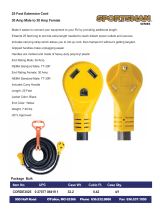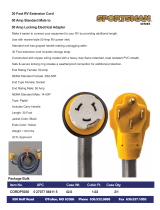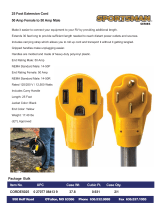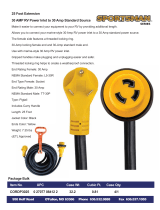
3
EN
16. WARNING! Before placing, installing, rigging, or suspending any speaker product, inspect all hardware, suspension, cabinets, transducers,
brackets and associated equipment for damage. Any missing, corroded, deformed, or non-load rated component could significantly
reduce the strength of the installation or placement. Any such condition severely reduces the safety of the installation and should be
immediately corrected. Use only hardware which is rated for the loading conditions of the installation and any possible short-term,
unexpected overloading. Never exceed the rating of the hardware or equipment.
17. WARNING! Consult a licensed, professional engineer regarding physical equipment installation. Ensure that all local, state and national
regulations regarding the safety and operation of equipment are understood and adhered to.
18. WARNING! KW122 – Do not use a loudspeaker support pole longer than 46" (1168 mm) when supported by QSC’s KW181 subwoofer. The
maximum distance between the bottom of the KW122, and the top of the KW181 shall not exceed 43" (1092 mm).
19. WARNING! KW152 – Do not use a loudspeaker support pole longer than 36" (914 mm) when supported by QSC’s KW181 subwoofer. The
maximum distance between the bottom of the KW152, and the top of the KW181 shall not exceed 33" (838 mm).
20. WARNING! KW153 – Do not use a loudspeaker support pole longer than 36" (914 mm) when supported by QSC’s KW181 subwoofer. The
maximum distance between the bottom of the KW153, and the top of the KW181 shall be 33" (838 mm).
21. CAUTION: The loudspeaker shall not be exposed to liquids. Do not place any objects filled with liquids, such as vases, drinks, etc. on
the loudspeaker.
Warranty (USA only; other countries, see your dealer or distributor)
QSC Audio Products 3 Year Limited Warranty
QSC Audio Products, LLC (“QSC”) guarantees its products to be free from defective material and/or workmanship for a period of three (3) years from
the date of sale and will replace defective parts and repair malfunctioning products under this warranty when the defect occurs under normal installa-
tion and use – provided the unit is returned to our factory or one of our authorized service stations via prepaid transportation with a copy of proof of
purchase (i.e., sales receipt). This warranty provides that the examination of the returned product must indicate, in our judgement, a manufacturing
defect. This warranty does not extend to any product which has been subjected to misuse, neglect, accident, improper installation, or where the date
code has been removed or defaced. QSC shall not be liable for incidental and/or consequential damages. This warranty gives you specific legal rights.
This limited warranty is freely transferable during the term of the warranty period.
Customer may have additional rights, which vary from state to state.
In the event that this product was manufactured for export and sale outside of the United States or its territories, then this limited warranty shall not
apply. Removal of the serial number on this product, or purchase of this product from an unauthorized dealer will void this limited warranty.
Periodically, this warranty is updated. To obtain the most recent version of QSC’s warranty statement, please visit www.qscaudio.com.
Contact us at 800-854-4079 or visit our website at www.qscaudio.com.
FCC Statement
NOTE: This equipment has been tested and found to comply with the limits for a Class B digital device, pursuant to Part 15 of the FCC Rules.
These limits are designed to provide reasonable protection against harmful interference in a residential installation. This equipment generates, uses
and can radiate radio frequency energy and, if not installed and used in accordance with the instructions, may cause harmful interference to radio
communications. However, there is no guarantee that interference will not occur in a particular installation. If this equipment does cause harmful
interference to radio or television reception, which can be determined by turning the equipment off and on, the user is encouraged to try to correct
the interference by one or more of the following measures:
• Reorient or relocate the receiving antenna.
• Increase the separation between the equipment and receiver.
• Connect the equipment into an outlet on a circuit different from that to which the receiver is connected.
• Consult the dealer or an experienced radio/TV technician for help.
© Copyright 2010, QSC Audio Products, LLC
QSC
®
is a registered trademark of QSC Audio Products, LLC
“QSC” and the QSC logo are registered with the U.S. Patent and Trademark Office
All trademarks are the property of their respective owners.























